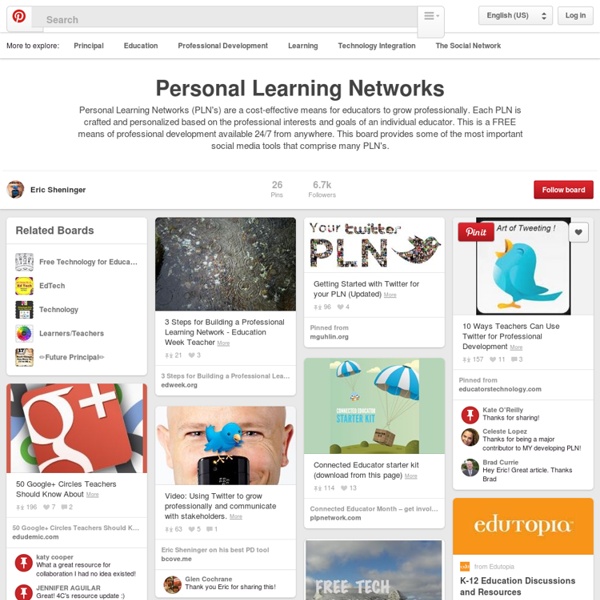



Personal Learning Networks for Educators: 10 Tips - Getting Smart by Guest Author - edchat, EdTech, PLN By Dr. Mark Wagner I often begin my workshop on personal learning networks (PLN) for educators by asking these questions: Who is in your learning network? I usually ask these questions at conferences, which are frequently only annual events – and rare treats for many educators. Learning to Network and Networking to Learn 1. 2. 3. 4. Networking Tools and Anecdotes The four tips above are the core activities of building a personal learning network, and they can be applied using various tools to connect with others online. 5. 6. 7. 8. Final Thoughts These final two tips will help keep your initial frustrations in perspective, and help you avoid the temptation to focus on unimportant metrics as you grow your network. 9. 10. Will Richardson, co-author of Personal Learning Networks: Using the Power of Connections to Transform Education has been a part of my personal learning network for years… and I was lucky enough to see him at a conference earlier this week.
Shelfari 3 Steps for Building a Professional Learning Network - Education Week Teacher Published Online: December 31, 2014 —Photo by Sean Chaffey, via Flickr Creative Commons By Brianna Crowley Recently, a colleague asked me, “What is a PLN?” She was taking a graduate course on technology implementation and was required to form a “PLN” using digital communities and tools. Her question prompted me to articulate how I define a professional learning network (PLN) and how I have shaped my own. A professional learning network is a vibrant, ever-changing group of connections to which teachers go to both share and learn. Teachers build PLNs the same way they build any network: by investing time to find and connect with people they trust, who have shared interests and passions. Although technology is often the vehicle to build connections, a PLN is about relationships. Let’s explore how to develop each of these layers of relationships and understand their role in professional learning. Step One: Find the Professionals Imagine you were moving to a new city. Feeling Overwhelmed? Web Only
Classroom 2.0 How to Create a Robust and Meaningful Personal Learning Network [PLN] This post describes how educators can develop a personal learning network that supports meaningful and relevant learning. The MOOC, Education Technology & Media, etmooc, is used here as a working example of how to develop a PLN. “My Personal Learning Network is the key to keeping me up-to-date with all the changes that are happening in education and how technology can best support and engage today’s students.” Brian Metcalfe: teacher, blogger at lifelonglearners.com I wrote a post recently about how to develop a personal learning environment [PLE], the need and benefits of doing so, for educators in particular. What is a PLN? PLN versus PLE The personal learning network can be a rich source of learning that fosters connections that become part of our professional development as the quotation at the beginning of the post from Metcalfe describes. In the etmooc we are primarily using Google+ Community , Blackboard Collaborate and Twitter to interact. Resources Like this: Like Loading...
EngageNY Math Click here to view all curriculum materials for English Language Arts and Mathematics. Curriculum modules in mathematics are marked by in-depth focus on fewer topics. They integrate the CCLS, rigorous classroom reasoning, extended classroom time devoted to practice and reflection through extensive problem sets, and high expectations for mastery. The time required to complete a curriculum module will depend on the scope and difficulty of the mathematical content that is the focus of the module (first priority cluster area for a given grade level). For example, the curriculum module relating to Grade 3 multiplication and division introduces initial ideas of multiplication and division in a brief period at the start of the year, continues to develop strategies and problem solving throughout the year, and includes materials to be used throughout the year for helping students reach fluency by the end of the year with single-digit multiplication and related division.
McTighe & Associates The Mulvey Principle